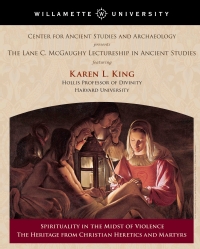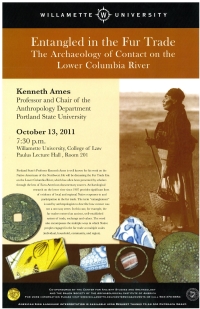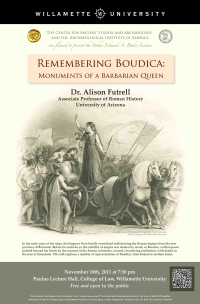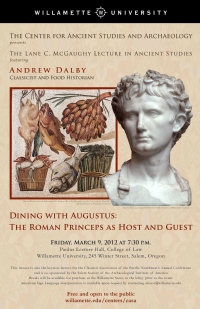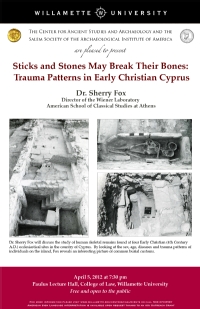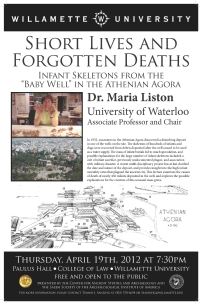2011-2012 Academic Year Archive
September 22, 2011
| King - Spirituality | Spirituality in the Midst of Violence: The Heritage from Christian Heretics and Martyrs (Lane C. McGaughy Lecture in Ancient Studies) , Hudson Hall, Mary Stuart Rogers Music Center Dr. Karen King Early Christianity was forged in a violent world. Not only Jesus’ violent death, but also those of his followers were formative events in Christian identity. From the prison diary of a mother sentenced to die in the arena, a bishop pleading to be allowed to suffer for his God, or theologians refusing to believe that God desires these brutal deaths, we can see Christians trying to meet these challenges ethically, spiritually, and communally. Dr. King's lecture will discuss their stories and reflect on the controversial legacy they left in theological imagination and practice. Sponsored by the Center for Ancient Studies and Archaeology |
October 13, 2011
| tbd | Entangled in the Fur Trade: The Archaeology of Contact on the Lower Columbia River, Paulus Lecture Hall, College of Law Dr. Kenneth Ames Co-sponsored by the Salem Society of the Archaeological Institute of America and the Willamette University Center for Ancient Studies and Archaeology
|
November 10, 2011
| tbd | Remembering Boudica: Monuments of a Barbarian Queen (Father Edward A. Bader Lecture), Paulus Lecture Hall, College of Law Dr. Alison Futrell Empire! Taxes! Violation! Massacre! In the early years of his reign, the Emperor Nero briefly considered withdrawing the legions from the new province of Britannia. Before he could do so, the stability of empire was shaken by revolt, as Boudica, a tribal queen pushed beyond her limits by the excesses of the Roman colonizers, exacted a horrifying retribution, with deaths in the tens of thousands. The revolt of A.D. 60 is presented by Romans as an example of power gone wrong during the hated Nero's anti-empire; the center of power is under the sway of the emperor's atrocious whims, the ruling elite in thrall to the emperor's desiring, irrational body. Meanwhile, on the fringes of empire, Roman military might is disrupted by Boudica, a barbarian who nevertheless lays claim to nobility and ancient traditions, a woman whose leadership transcends the physical limitations imposed by gender, a queen who champions the liberty Romans found antithetical to the very concept of monarchy. In the post-Roman period, Boudica, or Boadicea, becomes a key element in constructing British national identity; the meaning of Boadicea’s body, her sexuality, and her “barbarism” shift with different interpretations of gendered power and of the role played by Rome in Britain’s origins. This talk explores a number of representations of Boudica, from Roman to modern times. Co-sponsored by the Archaeological Institute of America and the Willamette University Center for Ancient Studies and Archaeology
|
February 8, 2012
| tbd | Stonehenge: New Discoveries (Kress Lecture), Paulus Lecture Hall, College of Law Dr. Mike Parker Pearson Stonehenge has long captivated the world with the mystery of its origins and use, and after seven years of new excavations there is now a completely new understanding as to the date and purpose of this enigmatic structure. One of the key breakthroughs has been to understand how Stonehenge formed part of a wider complex of monuments and landscape features on Salisbury Plain. The Riverside Stonehenge Project and the Feeding Stonehenge Project have been key in these new discoveries, and we now know much more about the people who built Stonehenge – where they came from, how they lived, and how they were organized. Not only has the recent work discovered a large settlement of many houses—thought to be for Stonehenge’s builders—at the nearby henge enclosure of Durrington Walls, but it has also helped to re-date Stonehenge and investigate its surrounding monuments and sites, many of which were hitherto undated and unknown. Principal Investigator for the Riverside Stonehenge Project and the Feeding Stonehenge Project, Professor Mike Parker Pearson, will be speaking on the current theories about Stonehenge – as an astronomical observatory, a centre of healing or a place of the ancestors – and the identity of its Neolithic builders. Parker Pearson will also touch on the discovery of a new monument called Bluestonehenge, located about one mile from Stonehenge, and what its discovery signifies. Potentially the most captivating question of all is how and why stones from 180 miles away were used to create Stonehenge, and while this is currently being investigated, Parker Pearson will give his professional opinion along with brand new results from the field. Parker Pearson is with the Department of Archaeology, University of Sheffield, and has also been Vice-President of the Prehistoric Society and the UK Archaeologist of the Year 2010. He attended undergraduate studies for European Archaeology at the University of Southampton and received his Ph.D. from Kings College, University of Cambridge. His research interests include Neolithic and Bronze Age Britain and Europe, funerary archaeology, society and change in Madagascar and the Indian Ocean, the ‘Barbarian’ Europe of the first millennia, and public archaeology and heritage. His work was featured on the National Geographic channel in the documentary “Stonehenge Decoded” (2008). Co-sponsored by the Willamette University Center for Ancient Studies and Archaeology and the Archaeological Institute of America’s National Lecture Program. Funding for this lecture has been provided by the Samuel H. Kress Foundation in New York, which strives to support the work of scholars in the fields of ancient art. |
March 9, 2011
| tbd | Dining with Augustus: The Roman Princeps as Host and Guest (Lane C. McGaughy Lecture in Ancient Studies) , Paulus Lecture Hall, College of Law Dr. Andrew Dalby In the lifetime of Augustus the Roman Republic became an Empire, and in hindsight we are right to call him its first emperor. How did he do it? Building on varied historical and literary sources the lecture will focus on the Roman arts of entertainment as they were practised in his time, and will show how creatively Augustus himself played the roles of host and patron. His triumphant career demonstrates that these skills were (as they still are) an essential ingredient of political success. Co-sponsored by the Willamette University Center for Ancient Studies and Archaeology, the Classical Association of the Pacific Northwest, and the Salem Society of the Archaeological Institute of America.
|
March 9-10, 2012
| tbd | 41st Annual Meeting of the Classical Association of the Pacific Northwest, College of Law |
April 5, 2012
| tbd | Sticks and Stones May Break Their Bones: Trauma Patterns in Early Christian Cyprus, Paulus Lecture Hall, College of Law Dr. Sherry Fox Human skeletal remains from four Early Christian ecclesiastical sites in Cyprus have been analyzed in an effort to discern the common burial customs, the demographic profiles (sex and age) of individuals from the site, along with pathological data such as the common diseases, and in particular, evidence for trauma from individuals dating to this time period on the island. There are few skeletal studies on Cypriot material from the Early Christian period. The largest site under study, the Hill of Agios Georgios (St. George’s Hill), is an inland site, located on a rise adjacent to the Pedeios River outside the Venetian walled city of the capital, Nicosia. Four churches/basilicas and their associated cemeteries dating from around the 4th century A.D. to the post-medieval period have been excavated at the Hill of Agios Georgios where today a chapel dedicated to St. George the Healer is situated. To date, approximately 28 of the total 216 individuals from the site are recovered from Early Christian contexts. The other, smaller church/basilica sites of Kalavasos-Kopetra (n=21), Alassa-Ayia Mavri (n=26), and Maroni-Petrera (n=6), are located near the south coast.Different patterns have emerged between the smaller, coastal sites when compared to the larger, inland site of the Hill of Agios Georgios. The pattern is particularly evident when examining evidence for trauma such as fracture types and locations. There are more fractures, greater variability among fractures, and fractures among more males, including cranial fractures and hand trauma, and in a later period, even parry fractures that characterize individuals at the urban and inland site of the Hill of Agios Georgios when compared with individuals from the South Coast who are characterized by more severe trauma from falls that include multiple fractures. Reasons for the different patterns in this preliminary study will be discussed. Co-sponsored by the Salem Society of the Archaeological Institute of America and the Willamette University Center for Ancient Studies and Archaeology
|
April 19, 2012
| tbd | Short Lives and Forgotten Deaths: Infant Skeletons from the “Baby Well” in the Athenian Agora, Paulus Lecture Hall, College of Law Dr. Maria Liston With the assistance of the Government of Canada / avec l'appui du gouvernement du Canada. Co-sponsored by the Archaeological Institute of America and the Willamette University Center for Ancient Studies and Archaeology.
|
April 21, 2011
| tbd | For more information, please visit: www.willamette.edu/cla/classics/conference/index |


